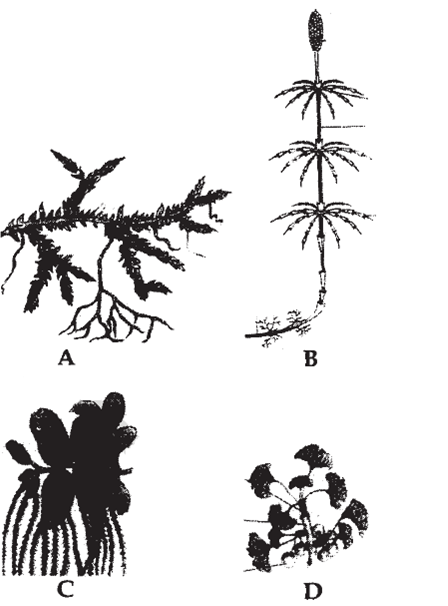 Multiple Choice Questions
Multiple Choice QuestionsThe correct sequence of plants in a hydrosere is
Oak → Lantana → scirpus→Pistia→Hydrilla→Volvox
Volvox → Hydrilla → Pistia → Scirpus → Lantana → Oak
Pista → Volvox → Scirpus → Hydrilla → Oak → Lantana
Pista → Volvox → Scirpus → Hydrilla → Oak → Lantana
B.
Volvox → Hydrilla → Pistia → Scirpus → Lantana → Oak
The various stages in a hydrosere are well studied in ponds. Pools or lakes. The various stages of hydrosere are:
Phytoplankton stage, eg, some blue-green algae, green algae (volvox), diatoms and bacteria, etc.
Rooted submerged stage, eg Hydrilla Vallisneria, etc.
Floating stage, eg, Nelumbo, Nymphaea, etc. Some free-floating species are pisita, Azolla, Lemna, etc.
Red -swamp stage, eg, species of Cyperaceae and Gramineae.
Forest stage, eg, Tropical rain forests, mixed forests of Almus, Acer, Quercus (oak), tropical deciduous forests.
Which one of the following is a vascular cryptogam?
Equisetum
Ginkgo
Marchantia
Marchantia
Which one of the following is considered important in the development of seed habit?
Dependent sporophyte
Heterospory
Haplontic life cycle
Haplontic life cycle
Examine the figure A, B, C, and D. In which one of the four options, all the items A, B, C and D are correct.
|
A |
B |
C |
D |
|
Chara |
Marchantia |
Fucus |
Pinus |
|
A |
B |
C |
D |
|
Equisetum |
Ginkgo |
Selaginella |
Lycopodium |
|
A |
B |
C |
D |
|
Selaginella |
Equisetum |
Salvinia |
Ginkgo |
|
A |
B |
C |
D |
|
Selaginella |
Equisetum |
Salvinia |
Ginkgo |
Select one of the following pairs of important features distinguishing Gnetum from Cycas and Pinus and showing affinities with angiosperms
the absence of resin duct and leaf venation
the presence of vessel elements and absence of archegonia
perianth and two integuments
perianth and two integuments
Flagellated male gametes are present in all the three of which one of the following sets?
Anthoceros, Funaria and Spirogyra
Zygnema, Saprolegnia and Hydrilla
Fucus, Marsilea and Calotropis
Fucus, Marsilea and Calotropis
In the prothallus of a vascular cryptogam, the antherozoids and eggs mature at different times. As a result
there is no change in success rate of fertilization
there is high degree of sterility
one can conclude that the plant is apomictic
one can conclude that the plant is apomictic
